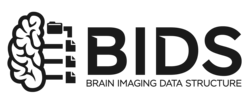Brain Imaging Data Structure
The Brain Imaging Data Structure (BIDS) is a standard for organizing, annotating, and describing data collected during neuroimaging experiments. It is based on a formalized file/folder structure and JSON based metadata files with controlled vocabulary.[1] This standard has been adopted by a multitude of labs around the world as well as databases such as OpenNeuro, SchizConnect, Developing Human Connectome Project, and FCP-INDI, and is seeing uptake in an increasing number of studies.[2][3][4]
 | |
| Status | Published |
|---|---|
| Year started | 2014 |
| Latest version | 1.4.0 June 2020 |
| Related standards | JSON, TSV, NIfTI |
| Domain | Neuroimaging |
| License | CC-BY 4.0 |
| Abbreviation | BIDS |
| Website | bids |
While originally specified for MRI data, BIDS has been extended to several other imaging modalities such as MEG,[5] EEG,[6] and intracranial EEG.[7]
History
The project is a community-driven effort. BIDS, originally OBIDS (Open Brain Imaging Data Structure), was initiated during an INCF sponsored data sharing working group meeting (January 2015) at Stanford University. It was subsequently spearheaded and maintained by Chris Gorgolewski. The project is now headed by a Steering Group [8] and maintained by Franklin Feingold, Stefan Appelhoff, Chris Markiewicz and the Poldrack Lab at Stanford. BIDS has advanced under the direction and effort of contributors, the community of researchers that appreciate the value of standardizing neuroimaging data to facilitate sharing and analysis.
References
- Krzysztof J; et al. (2016). "The brain imaging data structure, a format for organizing and describing outputs of neuroimaging experiments". Scientific Data. 3: 160044. doi:10.1038/sdata.2016.44. PMC 4978148. PMID 27326542.
- Poldrack, R. A., et al. "A phenome-wide examination of neural and cognitive function." Scientific data 3 (2016): 160110.
- Bigdely-Shamlo, Nima, Scott Makeig, and Kay A. Robbins. "Preparing laboratory and real-world EEG data for large-scale analysis: a containerized approach." Frontiers in neuroinformatics 10 (2016): 7.
- Nichols, Thomas E., et al. "Best practices in data analysis and sharing in neuroimaging using MRI." Nature neuroscience 20.3 (2017): 299.
- Niso, Guiomar; Gorgolewski, Krzysztof J.; Bock, Elizabeth; Brooks, Teon L.; Flandin, Guillaume; Gramfort, Alexandre; Henson, Richard N.; Jas, Mainak; Litvak, Vladimir; T. Moreau, Jeremy; Oostenveld, Robert; Schoffelen, Jan-Mathijs; Tadel, Francois; Wexler, Joseph; Baillet, Sylvain (19 June 2018). "MEG-BIDS, the brain imaging data structure extended to magnetoencephalography". Scientific Data. 5: 180110. doi:10.1038/sdata.2018.110. PMC 6007085. PMID 29917016.
- Pernet, Cyril R.; Appelhoff, Stefan; Gorgolewski, Krzysztof J.; Flandin, Guillaume; Phillips, Christophe; Delorme, Arnaud; Oostenveld, Robert (December 2019). "EEG-BIDS, an extension to the brain imaging data structure for electroencephalography". Scientific Data. 6 (1): 103. doi:10.1038/s41597-019-0104-8. ISSN 2052-4463. PMC 6592877. PMID 31239435.
- Holdgraf, Christopher; Appelhoff, Stefan; Bickel, Stephan; Bouchard, Kristofer; D’Ambrosio, Sasha; David, Olivier; Devinsky, Orrin; Dichter, Benjamin; Flinker, Adeen (December 2019). "iEEG-BIDS, extending the Brain Imaging Data Structure specification to human intracranial electrophysiology". Scientific Data. 6 (1). doi:10.1038/s41597-019-0105-7. ISSN 2052-4463.
- https://bids.neuroimaging.io/2019/12/31/meet-the-bids-steering-group.html